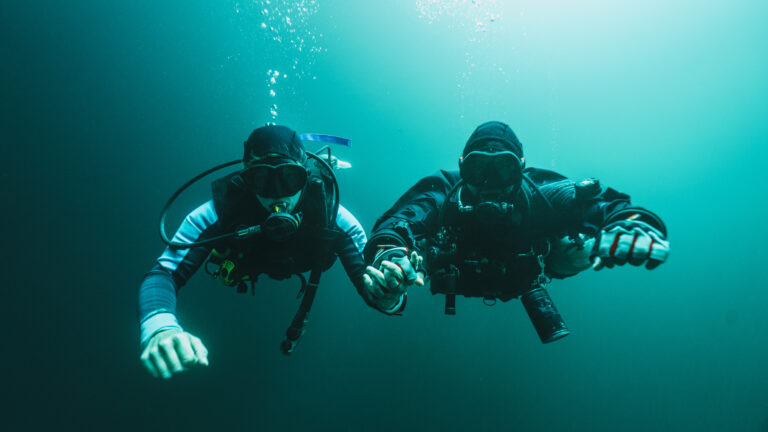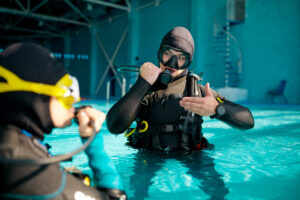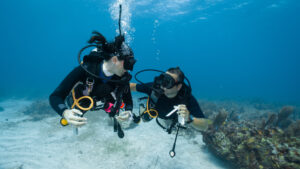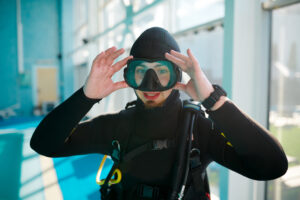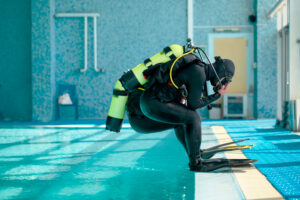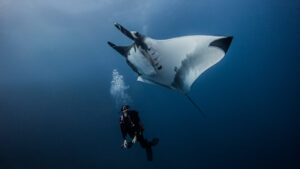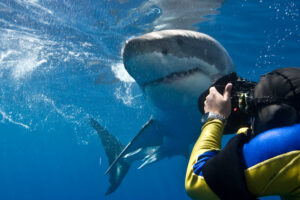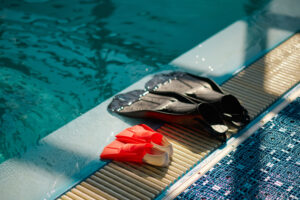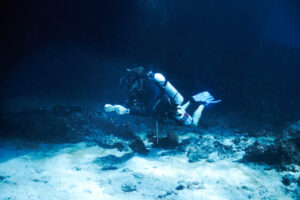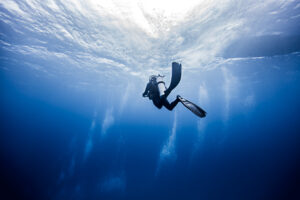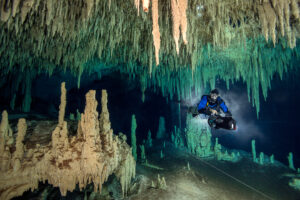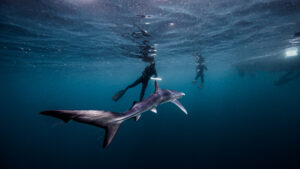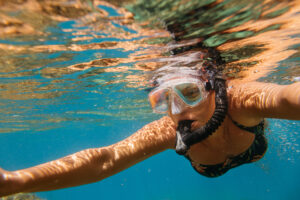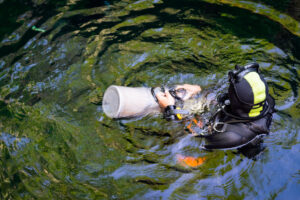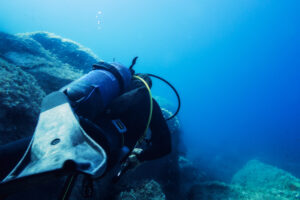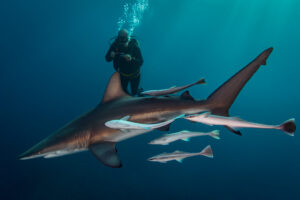What is a Buddy When Scuba Diving or Freediving?
A “buddy” in scuba diving or freediving refers to a designated diving partner who accompanies another diver during their underwater experience. The buddy system, a central part of these activities, was designed to enhance safety and promote teamwork. The buddy concept involves two divers working together, keeping an eye on each other, and offering help when necessary. This system is critical for ensuring that both individuals have a safe and enjoyable time underwater.
The role of a buddy goes beyond just watching out for another diver; it involves communication, mutual assistance, and shared responsibilities. This approach to diving encourages divers to stay within a reasonable distance from each other and to be able to react swiftly in emergencies. Whether through direct help or shared experiences, the buddy system is considered essential to successful diving.
The use of a buddy in diving is more than just a safety measure. It enhances the overall diving experience by allowing divers to share their underwater adventures with someone else. This combination of practical and personal benefits is why the buddy system remains an integral part of the diving world.
History of the Buddy System
The origins of the buddy system can be traced back to early military diving practices. In military operations, divers were paired together to ensure continuous communication and assistance in case of emergencies. These early practices emphasized the importance of having someone nearby who could assist if needed, especially during dangerous underwater missions.
As recreational scuba diving gained popularity, the buddy system was adopted into civilian diving training. By the mid-20th century, it became a standard feature of scuba diving courses worldwide. Organizations like the Professional Association of Diving Instructors (PADI) and the National Association of Underwater Instructors (NAUI) incorporated the buddy system into their training materials, emphasizing its importance for diver safety. The transition from military to recreational diving retained the same core principle: diving with a buddy provides a safeguard against underwater hazards.
The modern buddy system has evolved from its early days in military diving to become a critical element of all scuba diving training. Not only has it been a tool for safety, but it has also shaped the culture of diving, where camaraderie and mutual assistance are highly valued. It ensures that divers, regardless of experience level, are never alone in facing the challenges of the underwater world.
Importance of the Buddy System
Safety
Safety is the most significant reason behind the development and continuous use of the buddy system. A diving buddy can be a lifeline in emergencies, such as equipment failure or physical distress. In situations where a diver’s air supply is compromised, their buddy can share air, using either an alternate air source or their primary regulator. This sharing of air can prevent a situation from escalating into a life-threatening emergency.
Similarly, a buddy can assist in other emergencies, such as entanglement in underwater debris or equipment malfunction. Their presence enables quick reactions to unexpected problems, making the buddy system a vital safety protocol for all divers. For instance, if a diver experiences cramping or fatigue, a buddy can assist by towing them to safety or providing physical support until they recover.
The proximity of a diving buddy is essential. Being within arm’s reach or close visual contact ensures that divers can help each other quickly. The buddy system isn’t just about having a companion; it’s about being prepared for the unexpected, where mutual vigilance can make all the difference between a minor issue and a potentially dangerous situation.
Communication
Communication is another cornerstone of the buddy system. Underwater environments, especially in low visibility or challenging conditions, require divers to be in constant contact with their buddy. Although verbal communication is impossible underwater, divers rely on a range of hand signals to convey messages such as air supply status, directions, or potential hazards. Knowing that your buddy is attuned to your signals reduces stress and improves focus on the dive.
In low-visibility scenarios, a buddy is even more critical, as divers need to maintain close proximity and frequent communication to ensure they stay together. Hand signals become a vital means of ensuring both divers are aware of each other’s status and can react quickly if an issue arises.
Diving with a buddy also encourages pre-dive planning and communication. Before entering the water, buddies review their dive plan, equipment, and potential hazards, fostering an environment where both divers feel comfortable and prepared. This pre-dive communication helps to prevent misunderstandings underwater and promotes a smooth, enjoyable dive.
Skills Development
Beyond safety and communication, the buddy system offers a chance for divers to develop and refine their diving skills. When paired with a buddy of a similar experience level, divers can observe each other’s techniques, offer feedback, and work on improving areas such as buoyancy control or underwater navigation.
For less experienced divers, having a more seasoned buddy can provide valuable guidance. A more experienced diver can offer tips on improving finning techniques or how to handle specific underwater challenges. This mentor-mentee dynamic fosters a continuous learning environment that benefits both parties.
The buddy system also allows divers to monitor each other’s progress, offering constructive feedback that can improve overall diving proficiency. The opportunity to learn from another diver’s approach to underwater challenges can help both divers become more confident and competent.
Shared Experiences
One of the more personal benefits of the buddy system is the opportunity to share underwater experiences. Exploring marine environments is a highly visual and immersive activity, and having someone to share those moments with can enhance the overall enjoyment of the dive. Whether it’s spotting an elusive species of fish or navigating through a breathtaking coral reef, experiencing these moments together creates lasting memories and strengthens the bond between diving partners.
Sharing these experiences also means that both divers contribute to the dive’s success. Working together to navigate through the underwater environment, monitor air supplies, and complete the dive safely adds to the sense of accomplishment shared by both buddies.
Choosing the Right Buddy
Experience Level
When selecting a diving buddy, one of the most important factors is their experience level. Ideally, both divers should have a similar level of experience and certification. This similarity ensures that both individuals are familiar with the same diving procedures, which can significantly improve their ability to communicate and assist each other. For example, two divers with open water certification will likely understand the same safety protocols, while a mismatched pair could face communication and procedural challenges.
Diving with someone of a vastly different experience level can create imbalances in the dive. For example, if one diver is much more advanced, they may feel restricted by the limitations of the less experienced diver. Conversely, the less experienced diver may feel overwhelmed or unable to contribute equally to the dive’s success. Matching experience levels helps to create a balanced partnership where both divers can participate fully.
However, in some cases, more experienced divers may choose to pair with less experienced divers to provide mentorship. This can be a rewarding experience for both, as long as the dynamic is clearly understood and agreed upon before the dive.
Compatibility
Another essential factor to consider when choosing a buddy is compatibility. Divers with similar diving styles, goals, and interests will have a much more enjoyable experience together. For example, a diver interested in underwater photography may not be well-matched with a buddy focused on covering as much distance as possible. Misaligned interests can lead to frustration or misunderstandings during the dive.
Compatibility also extends to diving habits and comfort levels. Divers who are relaxed and enjoy slow, methodical dives may not work well with partners who prefer fast-paced, adventurous dives. It’s important for both divers to communicate their expectations and preferences before entering the water.
By choosing a buddy whose diving style aligns with their own, divers can ensure that both partners are working toward the same goals. This enhances the overall experience and reduces the chances of miscommunication or conflict during the dive.
Communication
Effective communication is crucial in selecting the right diving buddy. Both divers should feel comfortable discussing their dive plan, potential challenges, and expectations before entering the water. It’s essential to ensure that both buddies are familiar with the same hand signals and communication protocols, as this will be their primary method of interaction underwater.
Clear and open communication also allows both divers to address any concerns or uncertainties before the dive. This creates an environment of trust, where both partners feel confident in each other’s abilities and intentions. By establishing a solid communication foundation, divers can avoid misunderstandings and ensure that they are both working toward a safe and enjoyable experience.
Trustworthiness
Trust is the cornerstone of any successful buddy relationship. Divers must have confidence in their buddy’s skills, judgment, and reliability. Trustworthiness extends to a buddy’s ability to stay calm under pressure, make sound decisions in emergencies, and follow through on agreed-upon plans.
Trust can be built over time, as divers gain experience working together. However, even with a new buddy, it’s essential to establish a level of trust before entering the water. This trust allows both divers to focus on enjoying the dive, knowing that they can rely on each other in case of an emergency or unexpected challenge.
Buddy System Best Practices
Pre-dive Check
One of the most important aspects of diving with a buddy is conducting a thorough pre-dive check. This involves reviewing the dive plan, going over emergency procedures, and ensuring that both divers understand and agree on the goals of the dive. Pre-dive checks also include equipment checks, where both buddies inspect each other’s gear to ensure it is functioning correctly.
By conducting a pre-dive check, both divers can address any concerns or potential issues before entering the water, reducing the likelihood of problems arising during the dive. This check sets the tone for the dive, ensuring that both buddies feel prepared and confident.
Buddy Check
A buddy check is an essential part of the pre-dive routine. It involves both divers inspecting each other’s equipment to ensure that everything is secure and functioning properly. This includes checking air supply, buoyancy control devices, and regulators. By taking the time to check each other’s equipment, both divers can ensure that they are entering the water with the confidence that their gear is in good working order.
Buddy checks are a safety net, helping to prevent equipment malfunctions or other problems from arising during the dive. By working together, both buddies take responsibility for each other’s safety, reinforcing the importance of teamwork in diving.
Maintain Proximity
During the dive, it’s crucial that both buddies maintain proximity to each other. Ideally, buddies should remain within arm’s reach or at least within clear visual contact. This allows them to assist each other quickly in case of emergencies or challenges.
Maintaining proximity also helps both divers stay aware of each other’s air supply, depth, and overall condition. By staying close, buddies can provide immediate assistance if needed and ensure that both partners are safe throughout the dive.
Regular Communication
Regular communication during the dive is essential to maintaining awareness and ensuring both divers are comfortable and safe. Buddies should use agreed-upon hand signals or other methods to check in with each other at regular intervals. This helps to prevent any misunderstandings or issues from escalating.
By maintaining open lines of communication, both buddies can ensure they are on the same page throughout the dive. This enhances the overall experience and helps prevent any surprises or challenges from arising.
Post-dive Debrief
After the dive, a post-dive debrief is an important part of the buddy system. This involves discussing the dive, reviewing any challenges or successes, and providing feedback on the experience. The debrief helps both buddies learn from the dive and make any necessary improvements for future dives.
A post-dive debrief is also an opportunity to strengthen the bond between diving partners. By reflecting on the experience together, both buddies can celebrate their shared successes and address any challenges they faced.
Roles and Responsibilities of a Buddy
Monitoring
A key responsibility of a buddy is to monitor their partner throughout the entire dive. This begins with simple checks, such as regularly glancing at their air supply gauge to ensure there’s an adequate amount for the dive duration. If one diver is consuming air more rapidly than the other, it’s essential to adjust the dive plan to accommodate this discrepancy. Monitoring also involves keeping track of the diver’s depth to ensure they remain within safe limits for their training level and dive plan. Going too deep or staying at depth for too long can increase the risk of decompression sickness, so mutual awareness of depth is critical.
Monitoring goes beyond just checking air and depth; it includes paying attention to the physical and mental well-being of the buddy. Divers can experience a range of issues, from simple discomfort to serious symptoms like panic or fatigue. These signs might not always be immediately obvious, so it’s vital to observe body language and movement patterns. A buddy who seems sluggish or disoriented might be experiencing fatigue, cold, or even nitrogen narcosis, which affects judgment at greater depths. Constant observation allows a buddy to identify early warning signs of these conditions, which can help prevent escalation into more serious issues.
Regularly checking equipment throughout the dive is another essential aspect of monitoring. Regulators, buoyancy compensators, and other gear can malfunction unexpectedly, and in some cases, a diver might not even notice a problem with their own equipment. A buddy should stay alert to any visible issues, such as air bubbles from a malfunctioning regulator or an improperly fastened buoyancy control device. Detecting these problems early can prevent small issues from becoming life-threatening emergencies. The act of monitoring enhances safety and reassures both divers that they are looking out for each other.
Assistance
In addition to monitoring, a diving buddy is responsible for assisting their partner when necessary. The most common form of assistance involves helping with air supply in case of equipment failure or low air levels. Sharing air is a fundamental part of the buddy system, where one diver provides an alternate air source to their partner in an emergency. This procedure requires both divers to stay calm, communicate clearly, and coordinate their movements to ascend safely while sharing air. The ability to assist in this situation can be the difference between life and death, especially when far from the surface.
Assistance may also involve helping with buoyancy control, especially for less experienced divers or those struggling with the conditions. Buoyancy issues can result in difficulty maintaining a stable depth or floating too close to the surface or seabed, which can lead to collisions with the environment or uncontrolled ascents. A buddy can help by signaling their partner to adjust their buoyancy compensator or offering a hand to stabilize them while they regain control. This kind of assistance is not only practical but also boosts the diver’s confidence, knowing their buddy is there to support them in difficult moments.
Other forms of assistance might include helping a diver with equipment adjustments or managing physical challenges. For example, if a diver experiences cramping or fatigue, their buddy can step in to help massage the affected area or even tow the diver for a short distance. Such assistance is especially valuable in conditions like strong currents, where even experienced divers may need extra help to move effectively. By being prepared and willing to assist, a buddy ensures that minor inconveniences do not turn into significant problems that could disrupt the dive or lead to injury.
Emergency Response
Emergency response is a crucial aspect of the buddy system, requiring both divers to be prepared to act quickly in case of unexpected problems. Emergencies underwater can range from equipment malfunctions to serious physical issues, such as entanglement, injury, or even loss of consciousness. In these situations, the buddy must respond calmly and efficiently, often becoming the first responder in a life-threatening scenario. The success of an emergency response depends on clear communication, rapid assessment of the problem, and executing the appropriate rescue techniques.
One of the most common emergencies is equipment failure, such as a regulator malfunction or a burst air hose. In these cases, a buddy must quickly share their air supply through an alternate air source while maintaining control over their own equipment and ensuring both divers ascend safely. Another possible emergency is diver entanglement in underwater debris, such as fishing lines or seaweed. In this case, the buddy may need to carefully untangle the trapped diver without causing further distress or damage. Situations like these require quick thinking and effective execution of rescue skills, which are taught in most certification courses.
In more severe emergencies, such as loss of consciousness or a serious medical condition like decompression sickness, the buddy’s role becomes even more critical. The diver may need to perform an emergency ascent or provide life-saving first aid once at the surface. Understanding how to respond in such situations, including knowing when and how to call for additional help, can make a significant difference in the outcome. The ability to stay calm and act effectively under pressure is essential, as the success of an emergency response can directly impact the diver’s survival and recovery.
Navigation
Underwater navigation is an important aspect of diving, and sharing the responsibility for navigating between buddies can greatly enhance safety and enjoyment. Effective navigation ensures that divers stay on course and reach their intended destinations without getting lost or disoriented. Before entering the water, buddy teams should review their dive plan, which typically includes landmarks, waypoints, and compass headings to guide them through the dive. This pre-dive coordination helps both divers understand the route and reduces the likelihood of confusion underwater.
Once in the water, buddies must work together to maintain their course and adjust for any unforeseen challenges, such as currents or poor visibility. One diver may take the lead in navigation, using a compass or natural landmarks, while the other assists by verifying the direction or keeping track of the group’s position. This collaborative approach ensures that both divers are engaged in the process, minimizing the risk of disorientation or separation. In unfamiliar environments, it is particularly important for both divers to stay alert to their surroundings and use navigation aids effectively.
In some cases, navigation may involve adjusting the dive plan on the fly due to unexpected conditions. For example, if visibility is lower than anticipated or a planned landmark is not visible, the buddy team may need to make decisions about whether to continue or modify the dive. Having a buddy to help make these decisions reduces stress and ensures that both divers are comfortable with the choices being made. By sharing responsibility for navigation, both divers can stay oriented and focused, enhancing their safety and ensuring a successful dive.
Environmental Awareness
Environmental awareness is crucial for divers, both in terms of safety and responsible interaction with the underwater ecosystem. Maintaining awareness of their surroundings allows buddies to identify potential hazards, such as strong currents, sharp coral, or dangerous marine life. Divers should constantly scan their environment for these risks and communicate with each other if they spot anything that could pose a danger. For instance, if one diver notices a surge in current strength or sees a potentially harmful animal, they can signal their buddy to adjust their position or course accordingly.
In addition to identifying hazards, environmental awareness involves recognizing points of interest and sharing them with the buddy. Whether it’s a unique coral formation, a fascinating species of fish, or a shipwreck, these discoveries enhance the dive experience and create shared memories. Buddies can help each other navigate safely through these areas, ensuring that they maintain a respectful distance from delicate marine life and structures. This not only helps prevent accidents but also supports sustainable diving practices by avoiding damage to the environment.
A key component of environmental awareness is minimizing the impact on the underwater world. Divers should be mindful of their buoyancy, ensuring that they don’t accidentally touch or disturb marine life or kick up sediment that could obscure visibility. Buddies can remind each other to maintain proper buoyancy and positioning to avoid causing harm. By working together to stay aware of their surroundings, both divers contribute to a more respectful and responsible interaction with the underwater environment, promoting conservation and long-term sustainability for future diving experiences.
Buddy System in Group Diving
In group diving scenarios, the buddy system becomes even more important. Each diver should have a designated buddy, even within a larger group, to ensure that everyone has someone watching out for them. This helps to prevent divers from becoming separated from the group and ensures that everyone is accounted for throughout the dive.
Designated Buddies
When diving in a group, assigning designated buddies is critical to maintaining order and safety. Each diver must have a specific partner to monitor and assist throughout the dive. This pairing is not just a formality; it establishes accountability between divers, ensuring that no one is overlooked. In a large group, the absence of designated buddies can lead to confusion, as divers might assume someone else is watching out for a teammate. By formalizing buddy assignments, divers take responsibility for one another, ensuring every person is monitored and cared for throughout the dive.
Having designated buddies also promotes better situational awareness, as it is easier to manage smaller units within a larger group. Each buddy team acts as an independent, self-sufficient unit, capable of handling minor issues without distracting the rest of the group. This division of responsibility ensures that the group as a whole can function more smoothly and with less risk of accidents. If any pair encounters an issue, they can address it without unnecessarily involving other divers, unless assistance is required. Clear buddy assignments streamline the dive and foster a more structured, organized approach to underwater exploration.
In addition, designated buddies foster a sense of camaraderie and cooperation within the group. Diving with a specific partner encourages divers to build trust and mutual understanding, which is especially important in group dives where the dynamics can be more complex. By working closely with a designated buddy, each diver strengthens their connection with their partner, ensuring a smoother and more enjoyable dive. The buddy system becomes even more critical in group scenarios, where the complexity of managing multiple people underwater increases the need for clear, organized partnerships.
Group Communication
Effective group communication is essential to maintaining cohesion and safety during a group dive. Without proper communication, it’s easy for divers to become disoriented, especially in larger groups where the presence of more people can create distractions. Establishing clear communication protocols before entering the water helps ensure that every diver knows how to signal or alert others if a problem arises. This preparation might involve reviewing standard hand signals or using underwater signaling devices like noise makers or lights, which can be especially helpful in low-visibility environments or during night dives.
In group diving, communication extends beyond just hand signals; divers also need to remain aware of their positioning relative to the group. This requires ongoing, non-verbal communication between buddies to stay together while simultaneously staying connected to the rest of the group. Dive leaders play a crucial role in this process, often using signals or markers to guide the group, but each buddy team must maintain their own line of communication. Effective communication within buddy teams and with the group leader ensures that everyone is on the same page, reducing the risk of separation or confusion.
Good communication also promotes safety by ensuring that potential hazards are quickly identified and communicated to the rest of the group. For example, if one buddy team encounters strong currents or dangerous marine life, they must be able to signal the group to make adjustments in their dive plan. By fostering an environment where communication is constant and effective, group divers can navigate potential dangers more easily and ensure that everyone remains safe and accounted for throughout the dive.
Buddy Team Coordination
Buddy team coordination is a vital aspect of group diving, ensuring that each pair of divers stays synchronized with the larger group. Coordination begins before the dive, with buddies agreeing on basic plans such as descent and ascent rates, navigation routes, and emergency protocols. Without proper coordination, buddy teams might drift apart or inadvertently separate from the group, creating unnecessary confusion or safety risks. By pre-planning and discussing these details, buddy teams can operate cohesively within the broader context of the group dive.
During the dive, maintaining coordination involves keeping a constant awareness of the team’s position relative to the group and to each other. If one buddy team moves too quickly or too slowly, they risk disrupting the flow of the dive or even losing contact with the rest of the group. Effective coordination requires regular check-ins between buddies to ensure they are both comfortable with the dive’s pace and direction. Furthermore, buddy teams must remain vigilant to ensure they do not inadvertently interfere with other teams, such as by crossing paths or crowding around points of interest. This level of coordination helps prevent accidents and ensures that the dive proceeds smoothly.
Post-dive coordination is equally important, as buddy teams can debrief and reflect on their performance to improve future dives. By reviewing how well they maintained communication and proximity with both their buddy and the group, divers can identify areas for improvement. This reflection process strengthens team dynamics, ensuring that buddy teams become more efficient and synchronized over time. By coordinating actions effectively, buddy teams contribute to the overall success and safety of group dives.
Key Takeaways
The buddy system is an essential element of safe scuba diving. By choosing the right partner, communicating effectively, and following best practices, divers can ensure a safe and rewarding experience. Understanding the roles and responsibilities of a buddy enhances both individual safety and the overall quality of the dive.

